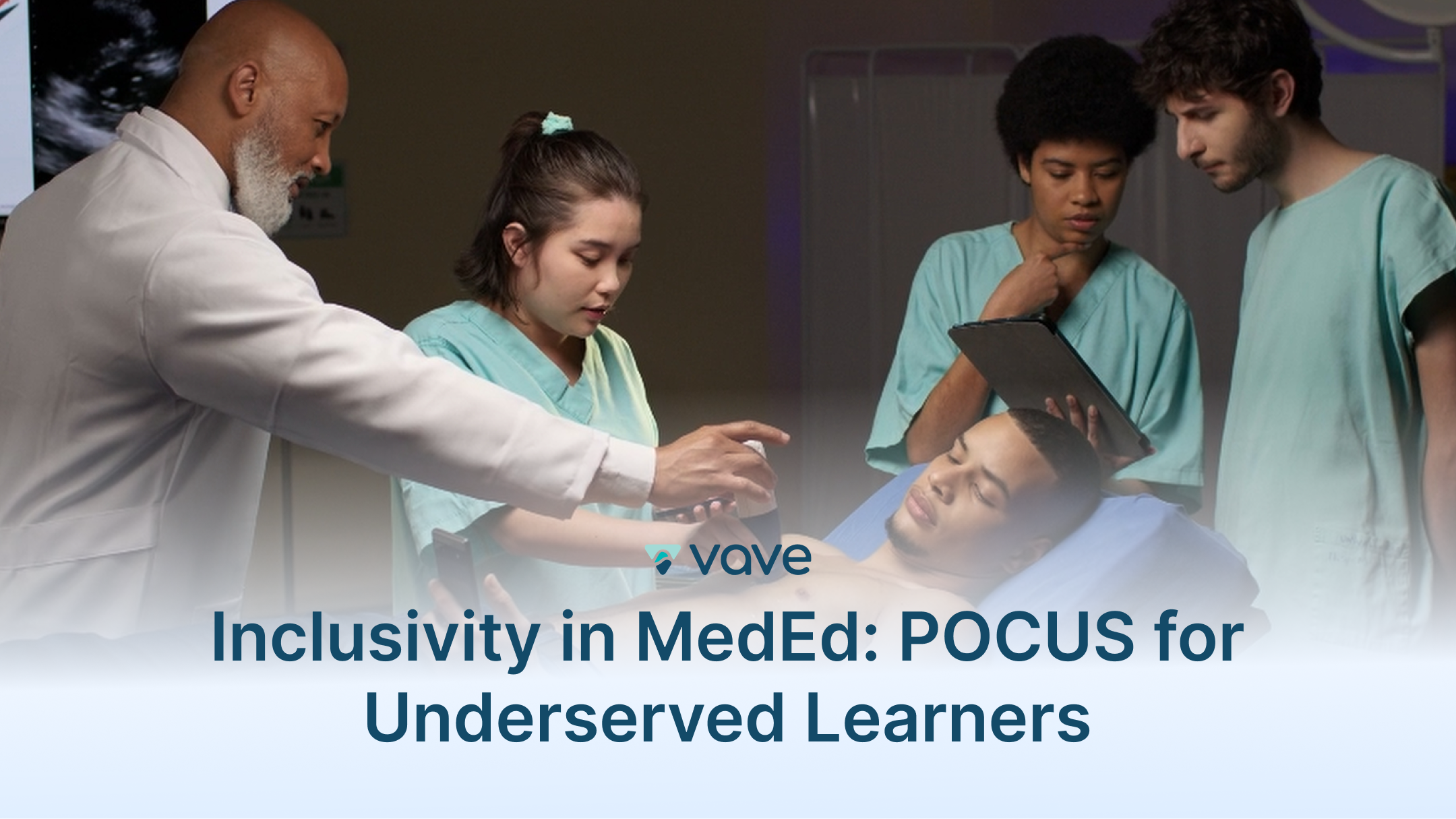Inclusivity in MedEd: POCUS for Underserved Learners
Point-of-care ultrasound (POCUS) is increasingly recognized as important for clinicians of the future, with residency programs and clinical practices rapidly embracing the technology. However, while undergraduate medical education (UME) has worked to keep up, many learners remain at risk of being left behind.
This article explores why longitudinal POCUS curricula are still rare and what schools can do to expand access to this essential technology.
Why POCUS Training is Essential for Modern Medical Students
Surveys show that over 91% of students now believe POCUS is a vital skill for their careers, with undergraduate training with the technology leading to:
- Better Learning Outcomes: Research shows that POCUS experience improves students’ anatomic knowledge and recall.
- Stronger Practical Skills: Studies find that POCUS experience also improves students’ clinical skills and performance on practical exams.
- Faster Professional Progression: Residency programs across numerous clinical specialties now require—or highly favor—applicants to have ultrasound experience. Early-career training, therefore, confers a professional advantage.
The takeaway is clear: integrating POCUS within undergraduate curricula is essential to improve students’ experience and future prospects, though most organizations still struggle to deliver the level of training students deserve.
[1] https://bmcmededuc.biomedcentral.com/articles/10.1186/s12909-025-06825-4
[2] https://www.sciencedirect.com/science/article/abs/pii/S0363018823000890
The Truth About Growing POCUS Popularity Within UME
The number of undergraduate MedEd courses with an approved POCUS curriculum has grown fast; estimates range from 57% to 66%. But several factors still leave most students underprepared for future POCUS usage:
- Limited Curriculum: Very few of these schools offer a comprehensive, longitudinal curriculum, with one study reporting that just 4.5% provide a 4-year POCUS course.
- Clinical Skills Gap: Research shows a drop-off in POCUS education from preclinical to clinical years, but data have shown that POCUS skills significantly decline in as little as 8 weeks of non-use.
- Practical Limitations: Many schools still have limited access to ultrasound devices, meaning students often gain relatively little direct experience using the technology.
This poses a question: given the consensus around the value of POCUS for UME, why is it still relatively underutilized?
What Drives Unequal POCUS Access—and How MedEd Institutions Solve the Problem
Recent studies have found that 94% of schools report barriers to wider POCUS implementation, including:
- 63% lacking trained faculty
- 54% lacking curricular time
- 44% lacking sufficient equipment
[3] https://pubmed.ncbi.nlm.nih.gov/34789665/
[4] https://pubmed.ncbi.nlm.nih.gov/40757940/
[5] https://pubmed.ncbi.nlm.nih.gov/34789665/
[6]https://onlinelibrary.wiley.com/doi/10.1002/jum.70021
[7]https://scholarworks.indianapolis.iu.edu/server/api/core/bitstreams/f7842543-7b86-479d-b670-dbde840b7eba/content
However, these issues may be symptoms rather than causes,may be influenced by reliance on older technology.
Expanding Access Using Handheld Devices
Handheld POCUS devices are used by nearly three-quarters of schools offering POCUS curricula, but almost none have switched to exclusively using handheld devices. This may explain why many of the barriers identified persist, as handheld devices can:
- Expand Clinical Curriculum: POCUS curricula often focus on preclinical years because students are more spread out during these times, creating logistical barriers to providing access to POCUS machines. But with cheaper handheld devices, schools can offer the same diagnostic quality for a fraction of the cost.
- Enable Remote Learning: Studies demonstrate that near-peer and train-the-trainer learning models match, and often outperform, expert teaching for certain POCUS tasks. Handheld devices enable such learning and reduce the staffing burden required to scale POCUS curricula.
- Eliminate Geographical Inequality: Handheld devices can help expand access to POCUS imaging to clinical students based in rural locations where imaging departments are less readily available.
All of which explains why more MedEd institutions are choosing Vave Health to launch or expand their UME curricula. Our cordless, handheld, whole-body ultrasound with a single PZT transducer enables medical schools to avoid prohibitive POCUS costs and makes adoption seamless with:
- Faculty Training: Use our comprehensive Train-The-Trainer program to equip faculty with expert knowledge on platform usage and curriculum integration.
- Review and Feedback: Gain faculty assistance for formative feedback and grading.
- Analytics and Tracking: Easily monitor and assess your students’ progress.
- Multiple Displays: Share live scanning sessions in real-time using VaveCast™ to facilitate collaboration and learning during patient exams.
Our team works with you to incorporate POCUS into your curriculum, leveraging pre-built learning modules, quizzes, and exams to customize your program while ensuring fast and easy adoption.
[8] https://onlinelibrary.wiley.com/doi/10.1002/jum.70021
[9] https://onlinelibrary.wiley.com/doi/10.1002/jum.70021
[10]https://pmejournal.org/articles/10.5334/pme.1613?utm_source=chatgpt.com
Want to ensure every learner gets access to this essential imaging technology?
Book a Demo













.webp)
.svg)
.webp)
.svg)





.svg)

.svg)
.svg)
